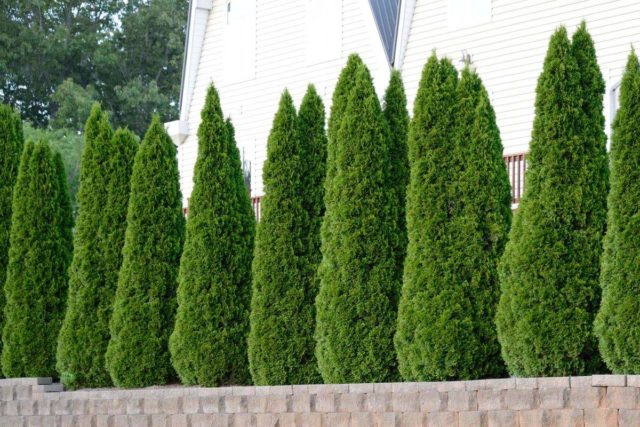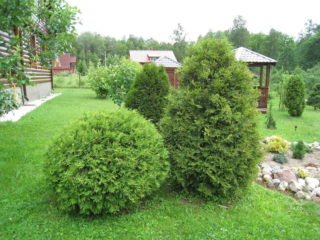Content
Growing thuja from seeds at home is a widespread method among gardeners. With it, you can simultaneously obtain a large number of plants for decorating a garden or summer cottage. Like any method, it has its disadvantages and advantages; this will be discussed in more detail below.
Is it possible to grow thuja from seeds at home?
Propagating thuja by seeds has a number of advantages. This method is suitable for all types and varieties of this crop. Unlike other methods, growing thuja from seeds allows you to simultaneously obtain many seedlings at home that have high hardiness and good health.
The method does not require any special investment; the seeds can be collected with your own hands. However, do not forget that when propagating thuja by seed, the varietal characteristics of the plant may not be preserved. Only vegetative methods of propagation can completely preserve them.As a result of growing conifers with seeds, a young seedling can grow into a thuja that is completely different from the mother plant from which the cones were collected. As a rule, varietal characteristics begin to appear in the second year after sowing the seeds. On average, growing thuja from seeds takes from 3 to 5 years.
Preparation of planting material
Thuja seeds can be purchased at specialized garden stores or prepared yourself. They begin to prepare material for planting thuja seeds at home in late summer or early autumn.
It is important to have time to collect cones with seeds before the fruits open. If plucking them from the tree is difficult, you can carefully separate the part of the shoot on which they are attached.
After the planting material has been collected, it should be laid out to dry on any flat surface in a dry, warm and well-ventilated place, protected from direct sunlight. Bright sun has a negative effect on seed germination. When drying planting material in the room, it is necessary to maintain a temperature no higher than 6 - 7 degrees Celsius.
Over time, the cones will dry out, open up, and it will be easier to extract the seeds from them. It is best to place paper under the cones, since the seeds, after full ripening, begin to spill out of the cones on their own. It will be much easier to collect them from a sheet of paper. The most convenient way to collect ripened seeds is to hold the cone over a sheet of paper and lightly tap it.
How to plant thuja seeds at home
In order for the plants to develop and grow well in the future, it is important to plant thuja seeds correctly.
There are a number of rules, following which, you can greatly facilitate the process of planting thuja from seeds and further caring for it.
When to plant thuja seeds
At home, sowing thuja seeds is best done in the fall. In this case, collected with your own hands, they will still be fresh, with a high percentage of germination. Overwintering in the ground outside, the seeds will undergo natural hardening, which will have a positive effect on the germination of seedlings. When sowing seed in the fall, seedlings, as a rule, appear earlier than when planting thuja with seeds in the spring, and young plants turn out to be more adapted to cold weather and require less care.
Selection of containers and soil preparation
At home, thuja seeds can be planted in boxes or directly in the garden bed. Growing in shallow boxes greatly simplifies the cultivation of seedlings, since, as needed, they can be moved to any convenient place.
The best option for thuja seedlings is containers whose height does not exceed 10 - 12 cm. In containers that are too deep, the soil located in the lower layer may begin to sour, however, you should not choose containers that are too low: in them the roots of neighboring plants will intertwine with each other , thereby suppressing each other’s development. It will be impossible to dive them without damage in the future. Another more convenient option is containers with cells.
The soil for growing thuja must be very nutritious. A ready-made substrate for coniferous crops, sold in garden stores, is ideal.To prepare a nutritious soil mixture at home, it is recommended to mix:
- 2 parts sand;
- 1 part of turf land;
- 1 part peat.
Preparing seeds for sowing
If you plan to plant thuja seeds in the fall, they will naturally stratify in the soil over the winter; there is no need to further harden them. When planting thuja seeds in the spring, it is recommended to first stratify them. For this procedure at home, the seeds must be placed in a container with damp sand and left in the refrigerator for 3-4 months. The bottom shelf for vegetables is ideal.
Thuja seeds can be hardened at home using another method:
- place the seed in a linen bag;
- for the winter, bury the bag in the ground to a depth of at least 30 cm;
- sprinkle fallen leaves on top.
Immediately before sowing, one more procedure will need to be performed - seed germination. To do this, they are soaked in warm water overnight. By the next morning the material will have swelled and will be ready for planting.
How to plant thuja seeds at home
After stratification and germination of thuja seeds, you can begin sowing them, for this you need:
- Place a drainage layer 2 - 3 cm thick, consisting of expanded clay or fine gravel, on the bottom of the box.
- Pour part of the nutritious soil substrate on top so that 2 - 3 cm to the edges of the box remain free. Level and lightly compact the soil.
- To disinfect the soil, it is recommended to spill it with a solution of potassium permanganate, which has a dark pink color.
- Form shallow furrows (up to 5 - 6 mm) at a distance of about 5 cm from each other.
- Sow thuja seeds in the furrows, trying to distribute them evenly. Do not place the seeds too close to each other.
- Sprinkle the crops with a layer of nutrient soil mixture no more than 1 cm thick.
- Lightly compact the surface using a board or your hands. Moisten with water from a spray bottle.
The first shoots will appear after approximately 20 - 25 days. After they appear, the film cover can be removed.
How to plant thuja seeds directly in open ground
When planting thuja seeds directly into open ground, it is important to take into account that the comfortable soil temperature for their germination is about 10 - 15 degrees Celsius. If the temperature is lower, seedlings may not appear.
It is best to sow seeds in open ground in the fall, then seedlings will appear in the spring much earlier, and young plants will be more viable and resistant to low temperatures.
Sowing seeds in open ground is carried out according to the same principle as sowing in boxes. You should not bury the seeds more than 5 cm into the soil. It is most convenient to first grow thuja seedlings in one bed, and only then plant them in separate areas.
How to grow thuja from seed
In general, caring for thuja seedlings in the open ground is not much different from caring for seedlings. Watering young thuja seedlings must be done carefully so as not to accidentally erode the soil. Experienced gardeners recommend watering plants using a fine spray bottle. If during watering the soil has eroded in some places, you need to carefully sprinkle these places with a thin layer of soil.
Watering should be moderate; thuja seedlings are watered as the soil dries out.At the same time, it is undesirable to allow either waterlogging or drying out of the soil. Stagnant moisture can be detrimental to seedlings.
In order for thuja seedlings to develop better, every two weeks you need to fertilize with mineral complex fertilizers with a high content of nitrogen, potassium and phosphorus. To prevent fungal diseases, thuja seedlings should be treated with fungicides. Fundazol has proven itself to be excellent.
When warm weather sets in, the box with thuja seedlings can be taken outside. Tender, still immature sprouts feel comfortable at temperatures from 17 to 23 degrees Celsius. The box should be placed in the shade or partial shade, so that direct sunlight does not fall on the seedlings. An excellent option would be a place shaded by the dense crown of a tall tree.
Exposure to the bright sun is contraindicated for young coniferous crops; direct sunlight can cause plant burns. That is why seedlings growing in open ground are recommended to be initially protected from the scorching sun using covering materials.
In the first year, seedlings reach a height of 8 - 10 cm. Thuja seedlings growing in boxes spend the winter in them. In winter, it is better to store boxes at a temperature of 14 to 18 degrees Celsius. Seedlings growing in open ground are mulched for the winter with peat, fallen leaves or straw.
Next summer, seedlings grown at home from boxes are planted in open ground for growing according to a 30x30 cm pattern. The bed should be located in partial shade. Transplant algorithm:
- Into the soil per 1 sq.m add 1 bucket of humus, 40 g of nitroammophoska, 250 g of wood ash. Dig on the bayonet of a shovel.
- Replant the seedlings so that the root collar remains flush with the soil. If deeply buried, the thuja may dry out and die.
- Water and mulch with peat. Further care of the plantings remains the same.
Transplanting seedlings to a permanent place
Thuja seedlings can be transplanted to a permanent place in the third year after sowing the seeds, when the height of the bush reaches about 50 cm. This can be done both in autumn and spring.
The planting site should be sunny and protected from the wind; in the shade, the thuja needles will turn yellow and thin out. The best option for thuja is sandy loam soil mixed with turf soil.
Algorithm for transplanting thuja seedlings to a permanent place:
- Place a drainage layer at the bottom of the planting hole.
- Form a small mound from the ground and place a thuja seedling on it.
- Cover with soil, not forgetting that the root collar should remain flush with the soil. Water and mulch with peat.
In addition, it is recommended to watch a video on how to grow thuja from seeds at home:
Conclusion
Growing thuja from seeds at home is a fairly lengthy process, which on average takes from 3 to 5 years. However, the result is definitely worth the effort, since this unpretentious evergreen tree will delight the eye for many years to come.














